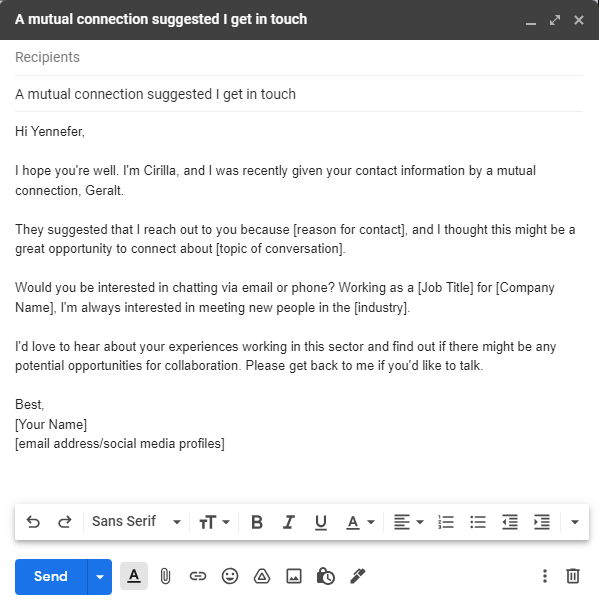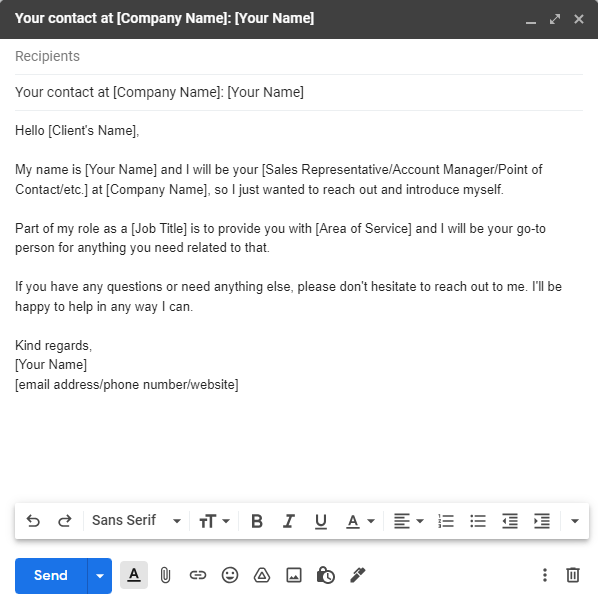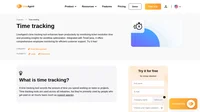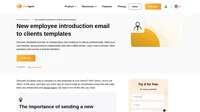- Email Templates
- How to introduce yourself in an email
How to introduce yourself in an email
Learn to craft effective professional introduction emails with tips on subject lines, body text, and common mistakes to avoid. Discover the significance of introduction emails and explore examples to make a strong first impression.

When you’re first making contact with someone for business reasons via email, it is courteous to introduce yourself properly. Following some general tips can help you write an effective introduction email.
Here, we will go over how to introduce yourself in an email so that you can make a good impression and have the greatest chance of success.
We will also look at some business email introduction examples that you can use and modify to suit your needs.
The importance of sending an introduction email
It is always polite to make an introduction when you are getting in touch with someone for the first time.
Even if you have already met the person at a recent event or conference, a greeting message can serve as a reminder. An introductory email helps you start on the right foot with the person you are contacting, setting the tone for future interactions.

Therefore, it is important to take some time to craft an introductory email that is both courteous and professional. In doing so, you are more likely to have a positive impact and establish a good rapport with the recipient from the start.
How to title an introduction email
When sending an introduction email, an eye-catching subject line will make your message stand out from the many others the recipient gets daily. A good subject line needs to be brief and to the point, as well as give the recipient an idea of what the email is about.
Include a brief statement of who you are and why you are contacting the person, but without going into too much detail. This will help the recipient understand the purpose of the email and, if done right, encourage them to open it.
State details such as:
- your name
- your job title
- the company you work for
- and/or the date and time of an event
Adding one or more of these bits of information to the header will allow the recipient to identify both you and the subject of your email before even reading it.
Introduction email subject line examples
- Introducing myself – [Your Name]
- A Warm Introduction from [Your Name]
- Greetings from [Your Company]
- Your contact at [Company Name]: [Your Name]
- Asking for information: [Your Name] from [Your Company]
- Meeting request: [Date and Time] with [Your Name]
- A mutual connection suggested I get in touch
- Request for a [Timeframe] call to discuss [Topic]
How to write an introduction email
When making an email introduction to someone, it is important to keep your message short and to the point. Writing a long and rambling text can be overwhelming for the recipient, who in many cases won’t already know who you are.
Start with common email greetings like “Hello,” “Good morning,” “Greetings,” or “Hi.” Then, state your name and the reason for your email in a few brief sentences.
When you are emailing someone for the first time, it is also nice to include a brief explanation of how you know the person or how you came to have their email address. For example, you might say “I was given your contact information by a mutual friend,” or “I saw your talk at the conference last month and wanted to reach out.”

Tip: If you have any mutual connections, be sure to mention it even if that person didn’t share the contact details of the recipient with you. This will help to establish a sense of trust and rapport with the target of your email from the start.
When sending a greeting on behalf of someone else, be sure to include that information in your message.
It’s also beneficial to include some additional details about who you are to provide some more background. To give them some more context, state information such as your position, company, and/or website, especially if it wasn’t already included in the subject line.
Always end with a courteous close such as “Thank you for your time,” “I look forward to hearing from you,” or “Kind regards”.
What to include in an introduction email
- brief greeting – “Hello” or “Dear”, etc.
- your name
- purpose of your message – why you are writing
- how do you know the recipient or how did you obtain their email address
- any mutual connections – person or event
- who you are writing on behalf (if applicable)
- additional information about yourself – job title, company, website
- a call to action (CTA) – what you would like the recipient to do next after reading your message
- your contact information – email, phone number, social media profiles, etc.
- courteous closing – e.g. “Thank you” or “Best wishes”, followed by your name
Introduction email samples
Introducing myself – [Your Name]
Hello [Recipient’s Name],
My name is [Your Name]. I was given your contact information by, [Mutual Contact’s Name], who thought we might have some common business interests.
I am currently working as a [Job Title] at [Company Name] and I am interested in learning more about [area of interest].
Would you be interested in having a call sometime so that we can chat further? You can reach me on [mobile phone number] if you’d like to talk sometime soon.
Thank you for your time,
[Your Name]
A warm Introduction from [Your Name]
Hi [Recipient’s Name],
I’m [Your Name] and I am reaching out to you because we have a mutual acquaintance, [Mutual Contact’s Name]. We met when they were working for [Company Name], where I still have a position as a [Job Title].
I heard that you will be attending the [Conference/Event Name] next week and I wanted to see if you’d be interested in meeting up there. I’d love to chat with you about [topic of conversation].
Please let me know what you think,
[Your Name]
[email address/social media profiles]
Greetings from [Your Company]
Dear [Recipient’s Name],
As a [Job Title] at [Your Company], I am always on the lookout for talented individuals who might be a good fit for our team.
I recently came across your profile and was impressed by your [area of expertise]. I would love to chat with you about your experience and see if there might be a potential match for one of our current openings.
Would you be interested in scheduling a call sometime next week? You can reach me on [phone number] if so.
Best wishes,
[Your Name]
[email address/website]
Your contact at [Company Name]: [Your Name]
Hello [Client’s Name],
My name is [Your Name] and I will be your [Sales Representative/Account Manager/Point of Contact/etc.] at [Company Name], so I just wanted to reach out and introduce myself.
Part of my role as a [Job Title] is to provide you with [Area of Service] and I will be your go-to person for anything you need related to that.
If you have any questions or need anything else, please don’t hesitate to reach out to me. I’ll be happy to help in any way I can.
Kind regards,
[Your Name]
[email address/phone number/website]
Asking for information: [Your Name] from [Your Company]
Hi [Recipient’s Name],
I’m [Your Name] from [Your Company]. We’re a [Company Type] that specializes in [area of expertise].
I came across your profile and noticed that you have a lot of experience in [area of interest]. I was hoping you could answer a few questions so that I can get a better understanding of the [topic of conversation].
Would you have a moment for a quick call [later today/tomorrow/next week] or at any time of your convenience? We’d love to hear your thoughts.
Thank you in advance,
[Your Name]
[email address/phone number/website]
Meeting request: [time and date] with [Your Name]
Hello [Recipient’s Name],
I am a [Job Title] at [Your Company], and I work in [area of expertise]. I will be in [Location] on [arrival date] and it would be great to meet with you to discuss [topic of conversation] if possible.
Please let me know if you would be interested in meeting for coffee or lunch on [time and date], or at any other time before [departure date] of your choosing if that is not suitable.
I would like to hear about your experiences working in the [industry], and I can also tell you more about the work that I do at [Company Name].
Very best wishes,
[Your Name]
[email address/phone number/social media profiles]
A mutual connection suggested I get in touch
Hi [Recipient’s Name],
I hope you’re well. I’m [Your Name], and I was recently given your contact information by a mutual connection, [Mutual Contact’s Name].
They suggested that I reach out to you because [reason for contact], and I thought this might be a great opportunity to connect about [topic of conversation].
Would you be interested in chatting via email or phone? Working as a [Job Title] for [Company Name], I’m always interested in meeting new people in the [industry].
I’d love to hear about your experiences working in this sector and find out if there might be any potential opportunities for collaboration. Please get back to me if you’d like to talk.
Best,
[Your Name]
[email address/social media profiles]
Request for a [timeframe] call to discuss [topic of conversation]
Hello [Recipient’s Name],
My name is [Your Name] and I am a [Job Title] at [Your Company].
I came across your profile and noticed that you have experience in [area of expertise]. I would love to discuss this further with you and see if there might be potential opportunities for collaboration.
Would you be interested in scheduling a [timeframe] call sometime [later today/tomorrow/next week] to discuss [topic of conversation]? I’m also available at a later date if you’re too busy at the moment.
Looking forward to hearing back from you and thanks for your time,
[Your Name]
[email address/phone number/website]
Introduction email good practices
Several pieces of advice are worth following when you’re reaching out to someone for business purposes. These tips will help your message achieve its purpose.
- Use a template – while it’s important to personalize each email, having a go-to introductory message can be a time saver if you have a lot of prospects to contact.
- Come up with a clear and concise subject line that reflects the purpose of your email – your name, company, and/or a brief reason for the message are all appropriate here (see the dedicated section above on titling your introduction email for more information).
- Start with a courteous greeting – addressing the recipient by name is always a good way to get a professional relationship off on the right track
- Introduce yourself in the first sentence or two – include your name, job title, and company (as applicable).
- Explain why you’re reaching out – try to focus on how your message will benefit the recipient and their business interests.
- Keep the self-introduction short and to the point – long emails are often ignored or not fully read.
- Use proper grammar and spelling – remember to proofread your email before sending it.
- Keep a business tone throughout – whether you’re in a formal setting or trying to establish a more casual rapport, it’s important to write a professional email.
- Be polite and humble – nobody likes arrogance so try to come across as someone interested in building a relationship rather than just looking for business opportunities for themselves or their company.
- If you can, find some common ground to bond over – that could be an event or conference attended, or even something non-business related like a shared love of sport, music, or books.
- End with a call to action – whether it’s arranging a meeting, responding to your request, or simply acknowledging receipt of the message, don’t forget to say what you want the recipient to do after reading your email.
- Include your contact information – make it easy for the recipient to get in touch with you by including your email address, phone number, and/or social media links.
- End with a courteous sign-off.

Summary
An introduction email is often the first point of contact you have with a prospective client, collaborator, or business partner. This can be the initial step towards building a professional relationship with them, so it’s important to get this greeting message right to make a good first impression.
Following the tips and examples provided in this article will help you write a professional introduction email that stands out in the recipient’s inbox, establishes respect, and has a good chance of achieving its purpose.
Take the time to craft a well-written self-introduction email sample to use for future business relationships and you’ll be one step ahead of the competition.
Build a professional relationships with LiveAgent
LiveAgent gives you the power to design your own customer email templates, thus helping you to improve the customer service. Curious about all the opportunities?
Frequently Asked Questions
How do you write an introductory email to a potential client?
The email should be professional and engaging, while also conveying the value of your product/service. It's important to personalize the email and show genuine interest in their business. A good introduction includes a brief explanation of who you are, what your company does, and how it can benefit the client. It's also helpful to include a call to action, such as scheduling a meeting or requesting further information.
What is a good introduction email for a job application?
It should be concise, professional, and tailored to the specific job and company. Include a brief introduction of yourself, specify the position you are applying for and where you found the job posting. You can also highlight your experience and skills that are relevant for the position. Express your enthusiasm for the opportunity and encourage further discussion.
What is the purpose of an introduction email?
Trying to establish contact with someone you have met briefly, whose work you admire, who you’re hoping to start a collaborative project with, or simply seeking advice and feedback. Whatever the reason, an introductory email is an opportunity to make a good impression and hopefully forge a lasting connection.
How do you introduce yourself to a new client?
When introducing yourself to a new client, start with a professional greeting, state your name and position, and briefly explain how you came to know about them or their business. Highlight what you and your company can offer, emphasizing potential benefits for the client. If possible, show familiarity with their work to convey genuine interest. Suggest a next step, such as a meeting or call, provide any necessary attachments for reference, and conclude with a thank-you note, ensuring you leave your contact details.
How can I make a good impression in an introductory email?
Make sure that your message is clear and concise. Introduce yourself and explain the purpose of writing without being too pushy. Also check that your email is free of grammar and spelling errors, as this may suggest that you’re careless or not taking the email recipient seriously. Finally, remember to be polite throughout so you don’t come across as too forward or aggressive.
What are some common mistakes to avoid when writing an introduction email?
Firstly, not personalizing the email or tailoring it specifically to the recipient. Secondly, not paying attention to their preferences or interests (which may be found on their e.g. social media profile). Thirdly, being too pushy or sales-oriented in the email and immediately trying to sell them something rather than focusing on building a relationship first. Finally, sending a long email that goes off on a tangent instead of being concise and to the point.
When should I send an introduction email to a new client?
It could be when trying to establish a connection with someone such as a potential client, or if you want to introduce yourself to someone new after e.g. meeting them at an event. Another appropriate time to send an introduction email is if you’re seeking advice from someone who you admire or feedback from a peer whose work is relevant to your own.
How long after meeting someone should I send an introductory email?
In general, it is polite to send an introductory email soon after making a new acquaintance to make a good impression and start developing a professional relationship. However, if you met someone at a networking event and got their business card, for example, it would be best to wait a day or two before sending them an email to not bombard them with messages. Judge for yourself and don’t be afraid to err on the side of caution, but also don’t wait too long or the recipient may forget who you are.
Why might an introductory email be ignored?
Maybe the email was not sent to the right person or the contact details you have are incorrect. Another reason could be that the email was not well written or was too promotional, which could result in it landing in the recipient’s spam folder. Additionally, if the subject line wasn’t relevant or informative, your email might never get opened. Finally, they may simply have a busy schedule and not have time to read their emails or are just not interested in what you have to say.
Should I send a follow-up email if I don't hear back after introducing myself?
Yes, it will increase the chances of your message getting across to the person you’re trying to reach. However, don’t come across as pushy or needy – nobody likes being hounded for a response. Also remain polite and respectful in your follow-up email, and if you don’t hear back after this or one more message then it’s best to move on.
Discover how LiveAgent's time tracking feature can enhance productivity and efficiency for your team. Monitor ticket resolution times, optimize workflows, and boost performance with seamless TimeCamp integrations and comprehensive employee monitoring. Start your free trial today and streamline your customer support operations effortlessly!
New employee introduction email to clients templates
Discover professional new employee introduction email templates to build trust, enhance client relationships, and ensure smooth transitions.
You will be
in Good Hands!
Join our community of happy clients and provide excellent customer support with LiveAgent.

Our website uses cookies. By continuing we assume your permission to deploy cookies as detailed in our privacy and cookies policy.

 Български
Български  Čeština
Čeština  Dansk
Dansk  Deutsch
Deutsch  Eesti
Eesti  Español
Español  Français
Français  Ελληνικα
Ελληνικα  Hrvatski
Hrvatski  Italiano
Italiano  Latviešu
Latviešu  Lietuviškai
Lietuviškai  Magyar
Magyar  Nederlands
Nederlands  Norsk bokmål
Norsk bokmål  Polski
Polski  Română
Română  Русский
Русский  Slovenčina
Slovenčina  Slovenščina
Slovenščina  简体中文
简体中文  Tagalog
Tagalog  Tiếng Việt
Tiếng Việt  العربية
العربية  Português
Português 


